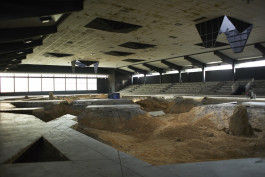
INS 001 After A Life Ahead Pierre Huyghe 2017
Header image:
Skulptur Projekte Münster
© Ola Rindal
Pierre Huyghe’s works often present themselves as complex systems characterized by a wide range of life forms, inanimate things, and technologies. His arranged organisms combine not only biological, technological, and fictional elements, they also produce an environment for humans, animals, and non-beings to evolve in no matter what, like microscopic unicellular organisms or viruses. (...)
For Münster’s Skulptur Projekte 2017, Huyghe developed a time-based bio-technical system in a former ice rink that closed in 2016. This involved bio- and media-technological interventions and required extensive architectural de- and reconstruction. All the processes taking place within the very large hall were mutually interdependent. (...)
By digging into the earth, Huyghe transformed the ground into a low-level hilly landscape. In some spots, concrete and earth, layers of clay, styrofoam, gravel debris, and Ice Age sand were found as far as a few metres underground, interspersed with leftover surfaces. This space was inhabited, for instance, by algae, bacteria, beehives, and chimera peacocks.
Biological life, real and symbolic architecture and landscapes, visible and invisible processes, and static and dynamic states were all fused into a precarious symbiosis.
© Ola Rindal

© Johannes Wigand
© Maximilian von Lachner


© Fanny Brandauer


Related Projects

INS 001 After A Life Ahead Pierre Huyghe 2017
Header image: Skulptur Projekte Münster © Ola Rindal
Text: Nico Anklam | Skulptur Projekte Münster
Pierre Huyghe’s works often present themselves as complex systems characterized by a wide range of life forms, inanimate things, and technologies. His arranged organisms combine not only biological, technological, and fictional elements, they also produce an environment for humans, animals, and non-beings to evolve in no matter what, like microscopic unicellular organisms or viruses. (...)
For Münster’s Skulptur Projekte 2017, Huyghe developed a time-based bio-technical system in a former ice rink that closed in 2016. This involved bio- and media-technological interventions and required extensive architectural de- and reconstruction. All the processes taking place within the very large hall were mutually interdependent. (...)
By digging into the earth, Huyghe transformed the ground into a low-level hilly landscape. In some spots, concrete and earth, layers of clay, styrofoam, gravel debris, and Ice Age sand were found as far as a few metres underground, interspersed with leftover surfaces. This space was inhabited, for instance, by algae, bacteria, beehives, and chimera peacocks.
Biological life, real and symbolic architecture and landscapes, visible and invisible processes, and static and dynamic states were all fused into a precarious symbiosis.

© Ola Rindal

© Johannes Wigand

© Maximilian von Lachner


© Fanny Brandauer
Related Projects

